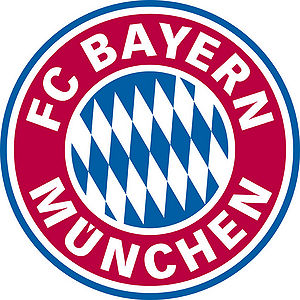
In 1900 the "FC Bayern München" football club emerged from the "Männerturnverein München 1879" (Men’s Gymnastic Club Munich 1879). As an elite "student club", FC Bayern was considered liberal in the period before and after the First World War; coaches hired from abroad led the club to its first sporting successes, including winning the German Championship in 1932. The numerous Jewish members and officials at FC Bayern had to withdraw during the Nazi era, when the club was largely unsuccessful. It was only in the post-war period that FC Bayern managed to build on its earlier successes. Since the 1960s, the club has repeatedly won cups and championships at both national and European level and has risen to become one of the most successful football clubs in the world, both in sporting and business terms.
From the foundation to the end of the First World War
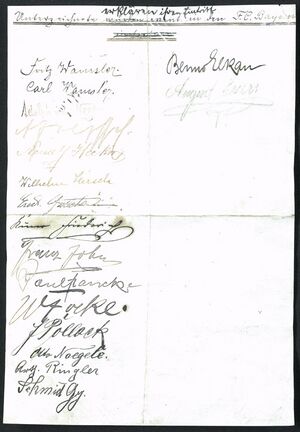
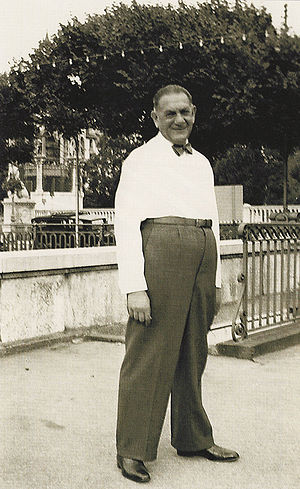
On 27 February 1900, eleven footballers, led by Franz John (1872-1952) left the Männerturnverein München von 1879 (MTV 1879 - Men’s Gymnastic Club Munich 1879) after the club had refused to allow their Fußballabteilung (football division), founded in 1897 to join the Süddeutscher Fußball-Verband (South German Football Association). They founded their own football club, FC Bayern (FCB), at Gasthaus Gisela on Fürstenstraße. White and blue were chosen as the club colours.
The foundation was largely due to the Jewish football enthusiast and official Gustav Manning (1874-1953). Manning, who had founded the football club in Freiburg (Baden-Württemberg) when he was there as a medical student, was also involved in the formation of the South German Football Association and not only attended the founding meeting of the Deutscher Fußball-Bund (German Football Association) in Leipzig (Saxony) as its representative but also supported Bayern’s withdrawal of from MTV. Among the 17 founding members of FC Bayern were two other footballers of Jewish origin, Josef Pollack (1880-1958) and Benno Elkan (1877-1960), later a well-known sculptor. Jewish members were also to have a decisive influence on the further development of the club up to 1933. For example, the club won its first German Championship in 1932 under its Jewish president Kurt Landauer (1884-1961) and the Jewish, Austro-Hungarian coach Richard "Little Dombi" Kohn (1888-1963). Because of this prominent role of Jewish club members, FCB was discredited as a "Jewish club" during the Nazi regime.
Initially, the city of Munich provided the club with the Schyrenwiese (Schyren Meadow) near Wittelsbacherbrücke as a playing field. However, FCB received a fenced-in property on Clemensstraße in Schwabing from its first patron, the cooker and oven manufacturer Friedrich Wamsler senior, as early as 1901.
The newly founded club's first match was probably a 5-2 win against 1. Münchner FC 1896 on the Schyrenwiese in March 1900. The winner of the first derby between FCB and the later city rival TSV München von 1860: is undisputed: Bayern won the match on 21 September 1902 with a clear 3-0 victory.
On 1 January 1906, the club merged with the largest Munich sports club, the Münchener Sport-Club (MSC). The financially strong MSC opened up new opportunities for Bayern. For the first time, prominent foreign teams could be invited to develop one’s own footballing skills in sporting competitions. Although Bayern were able to retain a high degree of autonomy in the MSC, they had to adapt their playing attire to the sports club. The players now wore white shirts and red shorts and were therefore called the "Reds" or "Red Shorts". FC Bayern's club colours have been red and white since then. Home games were initially played on a pitch on Karl-Theodor-Straße, and on a pitch on the outer Leopoldstraße since September 1907.
FC Bayern's membership structure was initially characterised by students, artists, business people and the self-employed. This was partly due to their home in Schwabing, Munich's intellectual and artists' quarter. The club itself also promoted its bourgeois-elitist character. For example, until 1908 the club's statutes stipulated that only "one-year volunteers" could join, i.e. men with a secondary school leaving certificate that allowed them to do military service voluntarily for just one year in a regiment chosen by themselves. FC Bayern therefore acquired the reputation of an elite "student club". At the same time, it was considered a liberal and open club that accepted footballers of any nationality, religion or ideology.
The club developed comparatively modern structures before the First World War. A separate sports committee was dedicated to administrative tasks and relieved the players of official duties. FC Bayern ambitiously sought to join the ranks of international football. Not only did they play against foreign teams and travel abroad, but they soon relied without exception on coaches from Great Britain, the motherland of football, where the game was most developed in terms of tactics and play. The first in a series of coaches from Great Britain was Thomas Taylor in the 1907/08 season. The first full-time coach was the Englishman Charles Griffiths (born 1882) in 1911.
The first successes were the Ostkreis (Eastern Circle) championship 1909/10 under the English coach George Hoer and the defence of this title in 1910/11.
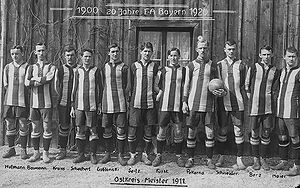
The club president at the beginning of the First World War was Kurt Landauer, who had taken over the office from Dr Angelo Knorr (1882-1932) in 1913. Knorr had resigned because of a homosexual affair and his impending prosecution. Landauer and almost the entire board of directors and sports committee as well as two thirds of all club members were called up for military service in summer 1914. Play came to an almost complete standstill until a war committee was formed in November 1914, which enabled the club to participate in the championships in the following war years. 61 club members had been killed in action by the end of the war.
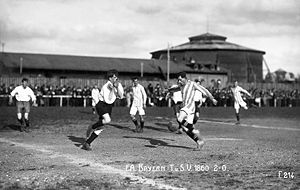
From the new beginning in 1919 to the end of the Second World War
In January 1919 Landauer assumed the office of president again and, with a one-year interruption in 1921, held it until 1933. In the spring of 1919, FC Bayern separated from MSC, which had largely collapsed during the First World War, and merged with the Turnverein Jahn, the largest Bavarian gymnastics club, to form the Turn- und Sportverein (TuSpV) München. Just four years later the separation followed, after the footballers had not received the sports field promised by the gymnasts. FCB was therefore independent for the first time since 1906. However, there was still a lack of a venue that could cope with the crowds of visitors at important matches. From the 1925/26 season onwards, the FCB used the stadium of its local rival, TSV München von 1860, on Grünwalder Straße. The club office was located at Dienerstraße 10 until 1932.
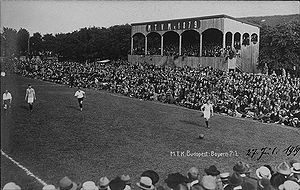
| Name | Date of birth/death | Term of office |
|---|---|---|
| Franz John | 1872-1952 | 1900-1903 |
| Dr Willem Hesselink | 1878-1973 | 1903-1906 |
| Dr Angelo Knorr | 1882-1950 | 1906-1907 |
| Dr Kurt Müller | 1907-1908 | |
| Dr Angelo Knorr | 1882-1950 | 1908-1909 |
| Otto Wagner | 1909-1910 | |
| Dr Angelo Knorr | 1882-1950 | 1910-1913 |
| Kurt Landauer | 1884-1961 | 1913-1914 |
| Fred Dunn | 1914-1915 | |
| Hans Tusch | 1915 | |
| Fritz Meier | 1915 | |
| Hans Bermühler | 1916 | |
| Fritz Meier | 1916-1919 |
| Name | Date of birth/death | Term of office | Nationality | Titles |
|---|---|---|---|---|
| Dr Willem Hesselink | 1878-1973 | 1902-1905 | Dutch | |
| Thomas Taylor | 1906-1909 | |||
| Dr. George Hoer | 1909-1911 | English | Ostkreismeister 1909/10, 1910/11 | |
| Charles Griffiths | geb. 1882 | 1911-1912 | English | |
| William James Townley | 1866-1950 | 1913-1921 | English |
The club developed into one of the top teams in German football under Kurt Landauer. He consistently relied on youth development and the superior football knowledge of international coaches, and since the beginning of the 1920s increasingly on representatives of modern "Danube football" from Hungary and Austria, such as Izidor "Dori" Kürschner (1885-1941), Leo Weisz (1900-1955), Kalman Konrad (1896-1980) and Richard Kohn.
The highlight of this sporting development was the German Championship in the 1931/32 season after a 2-0 victory over Eintracht Frankfurt in the final on 12 June 1932 in Nuremberg. This development came to an abrupt end with the "seizure of power" by the National Socialists.
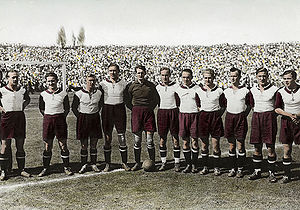
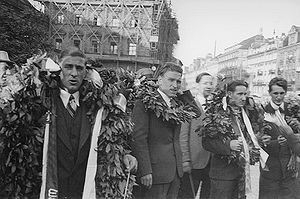
There are indications that the exclusion of Jewish members and officials began soon after Adolf Hitler‘s (NSDAP, 1889-1945, Reich Chancellor 1933-1945) appointment as Reich Chancellor on 30 January 1933. Kurt Landauer resigned as president on 22 March 1933. He was followed, among others, by Otto Beer (1891-1941), who had been responsible for the club's youth work for many years. Less than a month later, on 9 April 1933, the club also signed a declaration by the Süddeutscher Fußball- und Leichtathletikverband (SFLV – South German Football and Athletics Association) propagating the removal of Jews from the clubs. Just under two years later, on 27March 1935, the club included a paragraph in its statutes for the first time stating that persons of "non-Aryan" descent could not be members of the club. Half a year later this "Aryan paragraph" was made even stricter by removing all the exceptions which, for example, had allowed "non-Aryan" front-line fighters to remain in the club.
However, there are also justified doubts as to whether the National Socialists were able to take over the association club and without resistance. Jewish coach Richard Kohn became a club member in the summer of 1933. He also travelled with the team to Italy in June 1933 before he went to Switzerland. According to an announcement in Club-Nachrichten, the club's official newspaper, Kurt Landauer was to be awarded the Silver Badge of Honour in June 1934. In 1934 Landauer and other Jewish members were also still represented in the so-called Council of Elders, a body advising the club's management board. Even in the next two years the exclusion of all "non-Aryans" from club life does not seem to have been completely successful. For example, in the November 1936 issue of Club-Nachrichten, the so-called "Dietwart", i.e. the club’s appointee responsible for National Socialist retraining, complained about the harmful influence and the presence of members of "inhumane tribes and races" at the club's regular get-togethers.
The closeness and distance of the club’s presidents to the NSDAP leaders and the forcibly aligned municipal administration also remains controversial. For example, Dr Richard Amesmeier, who held the club presidency between July 1935 and November 1937, had in fact been a member of the NSDAP and the SA, since 1933, but resigned from the SA in 1939. Recently, doubts have even surfaced about the last club manager, Josef Sauter‘s, loyalty to the regime during the Nazi era, who had previously been considered the president with the closest ties to the National Socialists. For example, Sauter, who had never joined the NSDAP, acted as chair of a court for denazification trials in Günzburg in at least one trial after 1945.
FC Bayern was apparently neither a stronghold of active resistance against the Nazi regime, nor a loyal, strictly National Socialist model club. Rather, it seems that even before 1933 various groups were fighting for supremacy within the club, including a National Socialist faction, which was initially strongly represented in the club's ski department, which was founded in 1925. They only gradually gained influence in the club, against considerable opposition, when they took over the club newspaper and appointed the "Dietwarts", but without being able to take over the club completely and transform it into a Nazi club as they had in mind until 1945.
It should also be noted that the National Socialist “seizure of power” also brought about the club's sporting decline. At no time during the Third Reich was the club able to build on its success of 1932. The club also struggled after 1933 with a steady loss of members. The number of members dropped from 1389 in 1932 to 900 in 1936.
At the end of the war, the club office at Weinstraße 14 was destroyed; many members had died on the front or in aerial warfare. The club chronicle of 1950 records 56 fallen members, including the well-known league players Franz Krumm (1909-1943) and Josef Bergmaier (1909-1943). There were probably quite a few more.
Jewish club members had also fallen victim to Nazi crimes. Otto Beer and Siegfried Sundheimer were deported to Lithuania in November 1941 and murdered there. Bertold Koppel, suffered a similar fate when he and his family were deported to Piaski (Poland) and murdered there. Franz and Leo Landauer, brothers of former President Kurt Landauer, died in concentration camps, Franz Landauer on 10 July 1943 in Westerbork concentration camp (Netherlands), Leo Landauer after his deportation on 13 June 1942 in Majdanek concentration camp (Poland). The pharmacist Willy Buisson, probably the only non-Jew among the Nazi victims in the club, was sentenced to death by the People's Court on 27 April 1940 as a resistance fighter and executed in Berlin-Plötzensee on 6 September 1940.
| Name | Date of birth/death | Term of office |
|---|---|---|
| Kurt Landauer | 1884-1961 | 1919-1921 |
| Fred Dunn | 1921-1922 | |
| Kurt Landauer | 1884-1961 | 1922-1933 |
| Siegfried Herrmann | 1886-1971 | 1933-1934 |
| Dr Karl-Heinz Oettinger | 1934-1935 | |
| Dr Richard Amesmeier | 1935-1937 | |
| Franz Nußhardt | 1937-1938 | |
| Dr Josef Kellner | 1938-1943 | |
| Josef Sauter | 1943-1945 |
| Name | Date of birth/death | Term of office | Nationality | Titles |
|---|---|---|---|---|
| Izidor "Dori" Kürschner | 1885-1941 | 1921-1922 | Hungarian | |
| Leo Weisz | 1900-1955 | 1926-1928 | Hungarian | South German Champion 1927/28 |
| Kálmán Konrád | 1896-1980 | 1928-1930 | Hungarian | |
| Richard "Little Dombi" Kohn | 1888-1963 | 1930-1933 | Austrian | German Champion 1932 |
| Hans Tauchert | 1904-1958 | 1933-1934 | German | |
| Ludwig "Wiggerl" Hofmann | 1900-1935 | 1934-1935 | German | |
| Dr Richard Michalke | 1936-1937 | |||
| Heinrich "Heinz" Körner (born Heinrich Krczal) | 1893-1961 | 1937-1938 | Austrian | |
| Ludwig "Lutte" Goldbrunner | 1908-1981 | 1938-1943 | German | |
| Konrad "Conny" Heidkamp | 1905-1994 | 1943-1945 | German |
From the new start in 1945 to the present day
In spite of the fact that the Allies reluctantly issued playing permits, the club resumed play soon after the end oft he war. Initially it used the pitch of the Bayerischen Hypotheken- und Wechselbank on Grünwalder Straße. In 1948 the municipal office for physical education transferred part of the playgrounds on Säbener Straße to the club. Kurt Landauer, who had returned from exile in Switzerland, was re-elected President on 19 August 1947. With Landauer at the helm, who was politically unencumbered and also had good connections to Munich's Lord Mayor Karl Scharnagl (CSU, 1881-1963, Lord Mayor 1925-1933, 1945-1948) the club had to contend with less resistance to its new start than its politically discredited rival TSV München von 1860.
The newly founded Oberliga Süd (the southernmost of five regional leagues at the top level of association football in West Germany), of which FCB was one of the founding members, was launched on 4 November 1945. In 1955, the club was demoted to the 2nd league, but they were promoted again the following season. Its greatest success was the first victory in the Deutscher Vereinspokal (German Club Cup) in 1957.
Although football remained the core of its identity, the club expanded its range of sporting activities after the Second World War. A department for handball was founded in 1945, one for basketball and one for table tennis in 1946. While the rugby department, founded in 1922, was unable to resume playing after the war, the ski department, which had been dissolved in 1945, was reestablished in 1949. It was finally dissolved in 1955 though. The ice hockey department was even more short-lived, existing only between 1966 and 1969.
After the club had faced insolvency in the 1958/59 season, it managed to consolidate its finances in the following years under its president Roland Endler (1913-2003).
Wilhelm Neudecker (1913-1993, President 1962-1979) who was elected president in 1962, continued the modernisation process. He created a professional management structure by replacing the honorary chairman of the match committee with a paid technical director, among other things. This full-time manager was responsible for the operative business, and specifically for the club's personnel policy.
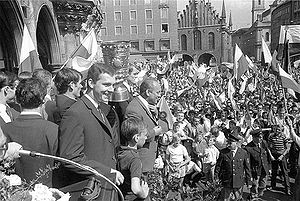
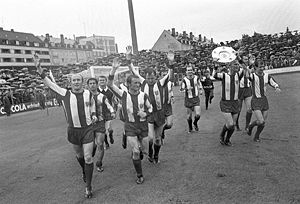
Despite large crowds of spectators and good results in the Oberliga Süd at the beginning of the 1960s, FCB was not one of the 16 founding members of the Bundesliga (Federal League), which started in 1963. The DFB was keen to ensure that all regions of the Federal Republic of Germany were represented in the new league. With TSV 1860 as the South German champion another club from Munich was already nominated.
FC Bayern, which consistently focused on promoting young regional talents such as Franz "The Kaiser" Beckenbauer (1945-2024) or Gerd "The Bomber of the Nation" Müller (1945-2021) already managed to get promoted to the Bundesliga in the 1964/65 season.
The young team was soon able to celebrate first successes. In 1966 it won the DFB Cup (a competition held annually by the DFB, in which football clubs from different levels of the German league system compete), which it defended in 1967. In 1967, the club also enjoyed its first international success by winning the European Cup Winners' Cup. In 1969 it won the second German Championship after 1932. Winning the DFB Cup at the same time meant the first "double" in the club's history. The most successful era to date began for FC Bayern under coach Udo Lattek (1935-2015) with their first victory in the 1974 European Champion Clubs' Cup. In the following two years they were able to repeat this success under coach Dettmar Cramer (1925-2015). In 1976, they also won the Intercontinental Cup for the first time.
At the end of the 1970s, Neudecker's authoritarian style of leadership was increasingly perceived as no longer being in keeping with the times. After a players' revolt against the appointment of Max Merkel (1918-2006) as coach, which he had pushed through, he resigned as president in 1979. Prior to this, he had appointed just 27-year-old Ulrich "Uli" Hoeneß (born 1952) as manager to suceed Robert Schwan (1921-2002) who had been in office since 1966. At the same time, there was also change within the team. Merited players left FCB, like Franz Beckenbauer and Gerd Müller, who moved to clubs in the Northern American Soccer League (NASL), or ended their active career, like Josef "Sepp" Maier (born 1944).
In 1980, the club won the German Championship for the first time since 1974. A phase of national dominance followed. By 1990, the FCB had won the German Championship six times and the DFB Cup three times. However, there was no success on the international stage.
The 1990s were characterised by many changes of coaches, a high turnover of players and a lack of strategic personnel planning. These were therefore comparatively unsuccessful years: 1994 and 1997 German champions, 1998 DFB Cup winner and 1996 UEFA Cup winner. This period was characterised by public conflicts among the club's players, coaches and representatives, which earned it the nickname "FC Hollywood". The dispute with Jürgen Klinsmann (born 1964) publicised by Lothar Matthäus (born 1961) in the Bild newspaper or the famous rant by coach Giovanni Trapattoni (born 1939) in his broken German in 1998 ("Was erlauben Strunz"; "schwach wie eine Flasche leer"; "Ich habe fertig") received considerable attention from the media.
The appointment of Ottmar Hitzfeld (born 1949) as coach in 1998 marked the start of a series of national successes again: Under him and his successors Felix Magath (born 1953), Louis van Gaal (born 1951), Jupp Heynckes (born 1954) und Josep "Pep" Guardiola (born 1971) FCB won the German Championship twelve times between 1999 and 2016 and was the DFB Cup winner nine times. International successes were also achieved again: Following the dramatic loss in the 1999 final against Manchester United, FCB won the Champions League in 2001. In 2013, the club experienced a sporting highlight under coach Jupp Heynckes, winning its first ever so-called "treble" of the German Championship, the DFB Cup and the Champions League.
| Name | Date of birth/death | Term of office |
|---|---|---|
| Franz Xaver Heilmannseder | 1945 | |
| Josef Bayer | 1945 | |
| Siegfried Herrmann | 1886-1971 | 1945-1947 |
| Kurt Landauer | 1947-1951 | |
| Julius Scheuring | 1951-1953 | |
| Adolf Fischer | 1953-1955 | |
| Alfred Reitlinger | 1955-1958 | |
| Roland Endler | 1913-2003 | 1958-1962 |
| Wilhelm Neudecker | 1913-1993 | 1962-1979 |
| Willi O. Hoffmann | born 1930 | 1979-1985 |
| Prof Dr Fritz Scherer | born 1940 | 1985-1994 |
| Franz "The Kaiser" Beckenbauer | 1945-2024 | 1994-2009 |
| Ulrich "Uli" Hoeneß | born 1952 | 2009-2014 |
| Karl Hopfner | born 1952 | 2014-2016 |
| Ulrich "Uli" Hoeneß | born 1952 | 2016-2019 |
| Herbert Hainer | born 1954 | seit 2019 |
| Name | Date of birth/death | Term of office | Nationality | Titles |
|---|---|---|---|---|
| Alfréd "Spezi" Schaffer | 1893-1945 | 1945 | Hungarian | |
| Richard Högg | 1946 | |||
| Josef Pöttinger | 1903-1970 | 1946-1947 | ||
| Franz Dietl | 1947-1948 | |||
| Alwin "Alv" Riemke | 1910-2009 | 1948-1950 | German | |
| David Davison | 1950 | |||
| Konrad Heidkamp; |
1916-2002 |
1951 | German | |
| Dr. Max Schäfer | 1907-1990 | 1951-1953 | German | |
| Georg "Buale" Bayerer | 1915-1998 | 1953-1954 | German | |
| Georg "Schorsch" Knöpfle | 1904-1987 | 1954 | German | |
| Jakob "Jakl" Streitle | 1916-1982 | 1955 | German | |
| Willibald Hahn | 1910-1999 | 1956-1957 | Austrian | DFB Cup 1956/57 |
| Herbert "Bertl" Moll | 1916-2002 | 1957-1958 | German | |
| Adolf Patek | 1900-1982 | 1958-1961 | Austrian | |
| Helmut Schneider | 1913-1984 | 1961-1963 | German | |
| Herbert Erhardt | 1963 | |||
| Zlatko "Tschik" Čajkovski | 1923-1998 | 1963-1968 | Yugoslavian | DFB cup 1965/66 |
| Branko Zebec | 1929-1988 | 1968-1970 | Yugoslavian | DFB Cup 1968/69; German Champion 1968/69 |
| Udo Lattek | 1935-2015 | 1970-1975 | German | European Champion Clubs' Cup 1973/74; German Champion 1971/72, 1972/73, 1973/74, 1984/85, 1985/86, 1986/87; DFB Cup 1970/71, 1983/84, 1985/86 |
| Dettmar Cramer | 1925-2015 | 1975-1977 | German | European Champion Clubs' Cup 1974/75, 1975/76; Club World Cup 1976 |
| Gyula Lórant (born Gyula Lipovics) | 1923-1981 | 1977-1979 | Hungarian | |
| Pál Csernai | 1932-2013 | 1979-1983 | Hungarian | German Champion 1979/80, 1980/81; DFB Cup 1981/82 |
| Reinhard Saftig | born 1952 | 1983 | German | |
| Udo Lattek | 1935-2015 | 1983-1987 | German | German Champion 1984/85, 1985/86, 1986/87; DFB Cup 1983/84, 1985/86 |
| Jupp Heynckes | born 1945 | 1987-1991 | German | German Champion 1988/89, 1989/90 |
| Søren Lerby | born 1958 | 1991-1992 | Danish | |
| Erich Ribbeck | born 1937 | 1992-1993 | German | |
| Franz "Der Kaiser" Beckenbauer | 1945-2024 | 1993-1994 | German | German Champion 1993/94 |
| Giovanni Trapattoni | born 1939 | 1994-1995 | Italian | |
| Otto Rehhagel | born 1938 | 1995-1996 | German | |
| Franz "The Kaiser" Beckenbauer | 1945-2024 | 1996 | German | UEFA Cup 1995/96 |
| Giovanni Trapattoni | born 1939 | 1996-1998 | Italian | German Champion 1996/97; DFB Cup 1997/98 |
| Ottmar Hitzfeld | born 1949 | 1998-2004 | German | Club World Cup 2001; Champions League 2001; German Champion 1998/99, 1999/2000, 2000/01, 2002/03; DFB Cup 1999/2000, 2002/03 |
| Felix Magath | born 1953 | 2004-2007 | German | German Champion 2004/05, 2005/06; DFB Cup 2004/05, 2005/06 |
| Ottmar Hitzfeld | born 1949 | 2007-2008 | German | German Champion 2007/08; DFB Cup 2007/08 |
| Jürgen Klinsmann | born 1964 | 2008-2009 | German | |
| Jupp Heynckes | born 1945 | 2009 | German | |
| Louis van Gaal | born 1951 | 2009-2011 | Dutch | German Champion 2009/10; DFB Cup 2009/10 |
| Andries Jonker | born 1962 | 2011 | Dutch | |
| Jupp Heynckes | born 1945 | 2011-2013 | German | Champions League 2012/13; German Champion 2012/13; DFB Cup 2012/13 |
| Josep "Pep" Guardiola | born 1971 | 2013-2016 | Spanish | FIFA Club World Cup 2012/13; UEFA Super Cup 2013; German Champion 2013/14, 2014/15, 2015/16; DFB Cup 2013/14, 2015/16 |
| Carlo Ancelotti | born 1959 | 2016-2017 | Italian | German Champion 2016/17; DFL Supercup 2016, 2017 |
| Willy Sagnol | born 1977 | 2017 | French | |
| Jupp Heynckes | born 1945 | 2017-2018 | German | German Champion 2017/18 |
| Niko Kovač | born 1971 | 2018-2019 | Croatian | German Champion 2018/19; DFB Cup 2018/19; DFL Supercup 2018 |
| Hans-Dieter „Hansi“ Flick | born 1965 | 2019-2021 | German | German Champion 2019/20, 2020/21; DFB Cup 2019/20; Champions League 2020; FIFA Club World Cup 2020; UEFA Super Cup 2020; DFL Supercup 2020 |
| Julian Nagelsmann | born 1987 | 2021-2023 | German | German Champion 2021/22; DFL Supercup 2021 |
| Thomas Tuchel | born 1973 | 2023-2024 | German | German Champion 2022/23 |
| Vincent Kompany | born 1986 | since 2024 | Belgium |
Sporting successes
German Football Champion
1931/32; 1968/69; 1971/72; 1972/73; 1973/74; 1979/80; 1980/81; 1984/85; 1985/86; 1986/87; 1988/89; 1989/90; 1993/94; 1996/97; 1998/99; 1999/2000; 2000/01; 2002/03; 2004/05; 2005/06; 2007/08; 2009/2010; 2012/13; 2013/14; 2014/15; 2015/16; 2016/17; 2017/18; 2018/19; 2019/20; 2020/21; 2021/22; 2022/23.
DFB Cup
1957; 1966; 1967; 1969; 1971; 1982; 1984; 1986; 1998; 2000; 2003; 2005; 2006; 2008; 2010; 2013; 2014; 2016; 2019; 2020.
German Supercup
1987; 1990; 2010; 2012; 2016; 2017; 2018; 2020; 2021.
German League Cup
1997; 1998; 1999; 2000; 2004; 2007.
Champions-League / European Champion Club’s Cup
1974; 1975; 1976; 2001; 2013; 2020.
UEFA-Cup
1996.
European Cup Winners‘ Cup
1967.
Intercontinental Cup
1976; 2001.
FIFA Club World Cup
2013; 2020.
UEFA Super Cup
2013; 2020.
Identity and image since 1945
At the beginning of the Bundesliga in the early 1960s, TSV 1860 Munich was the established major club in Munich, winning the DFB Cup in 1964 and the German Championship in 1966, while FCB was the up-and-coming underdog, whose young team thrilled fans with offensive football. It was not until the great international successes of the 1970s and the national dominance of the 1980s that FC Bayern became the largest and most important club in the Bundesliga, admired and revered by fans all over Germany and the world. Today FCB is the largest sports club in the world with 284,041 members (as of 2016).
| Season | Club members | Fan clubs | Fan club members |
|---|---|---|---|
| 2000/01 | 91.288 | 1.909 | 115.343 |
| 2001/02 | 95.195 | 1.980 | 121.348 |
| 2002/03 | 96.440 | 2.055 | 132.308 |
| 2003/04 | 97.810 | 2.123 | 136.563 |
| 2004/05 | 104.720 | 2.189 | 146.009 |
| 2005/06 | 121.119 | 2.290 | 156.673 |
| 2006/07 | 135.752 | 2.329 | 164.580 |
| 2007/08 | 147.072 | 2.437 | 176.976 |
| 2008/09 | 151.227 | 2.535 | 181.688 |
| 2009/10 | 162.181 | 2.764 | 190.745 |
| 2010/11 | 171.345 | 2.952 | 204.235 |
| 2011/12 | 187.865 | 3.202 | 231.197 |
| 2012/13 | 195.689 | 3.576 | 262.077 |
| 2013/14 | 233.427 | 3.749 | 283.558 |
| 2014/15 | 251.315 | 3.968 | 306.770 |
| 2015/16 | 270.329 | 4.157 | 325.415 |
This development went hand in hand with an expression of extraordinary self-confidence as the untouchable number one in football, at least in Germany. The club sums up this self-image with the slogan "Mia san Mia" (“We are who we are”).
This pronounced self-confidence, which the club’s representatives repeatedly and proactively displayed, naturally provoked opposition. As much admiration and affection the club receives from many football fans, as much dislike it is shown by individual opposing fan groups. FCB therefore also stands for the arrogance of success, which undermines the competitiveness of other Bundesliga clubs with its power and money.
This image of FC Bayern as a club of (arrogant) winners and established players was reinforced by its close ties to the CSU. The club has also had personal contacts with party leaders since Wilhelm Neudecker's era. This already traditional closeness is most evident in the membership of former Bavarian Minister President Edmund Stoiber (CSU, born 1941, Minister President 1993-2007) on the FC Bayern AG supervisory board.
While for a long time only current sporting successes shaped FC Bayern's self-image, since the mid-2000s the club has also rediscovered its history, including its Jewish past. However, the incentive to deal with its own history even before 1945 did not come from the club and its officials themselves. The push came from outside, from researchers and journalists, but also from FC Bayern fans. It was the ultra group "Schickeria" in particular that brought the Jewish President Kurt Landauer back into the club's consciousness. Among other things, they have been organising an anti-racist Kurt Landauer tournament since 2006 and commemorated him with a grand choreography at a Bundesliga match in February 2014 together with the fan association "Club No. 12". Since 2012, the club has been presenting its history and sporting successes in its own museum at the Allianz Arena, the FC Bayern Erlebniswelt, where events and (temporary) exhibitions remind us of its history and personalities associated with the club.
Economic dominance
The foundation for the club's economic dominance was laid by the sporting successes in the 1970s. FCB subsequently rose to become the most popular club in Germany, which was able to use one of the largest football stadiums in the Bundesliga since 1972, the Olympic Stadium. High revenue from tickets therefore laid the foundation for economic success. In addition, there were extremely lucrative advertising deals, for example in 1989 with "Adam Opel AG", which consolidated its financial edge over the competition.
Uli Hoeneß was also one of the first managers in the Bundesliga to recognise the economic potential for football that arose from the new competition in the television sector after the entry of private broadcasters. However, when it came to the distribution of the revenue from broadcasting rights, which exploded in the 1990s, among the clubs, FCB increasingly challenged the principle of solidarity by demanding a larger share of the revenues with reference to its own pulling power for the Bundesliga and in view of other European leagues. Although FC Bayern was able to increase its income from broadcasting revenue, it remains modest compared to the income of the major clubs in the English Premier League.
Even critics of the club praise FCB's solid and very successful economic and financial policy since the end of the 1980s, which is particularly associated- with the club's long-standing manager and president, Uli Hoeneß. While some clubs in Germany, and in particular those in the Italian and English leagues, took on high levels of debt or were sold to an investor in order to buy success through expensive player transfers, FCB has very low net debt. The club's healthy economic situation also enabled it to repeatedly support financially ailing competitors, such as Borussia Dortmund, which it helped out with a loan of two million euros in 2004.
However, even FCB cannot completely escape the economic developments in world football, in particular the dramatically rising transfer fees and salaries for the industry's top stars. Even if the club has not been willing to pay top prices for superstars like Cristiano Ronaldo (born 1985) or Gareth Bale (born 1989) so far, it still has to spend far more money on player commitments than it did in the 1990s. The professional football department was spun off into "FC Bayern München AG" in 2002 to remain internationally competitive and to generate additional income. The Adidas, Audi and Allianz groups became shareholders as a result. While the club thus acquired new money, its business partners can use FC Bayern's image as the most successful German club for advertising.
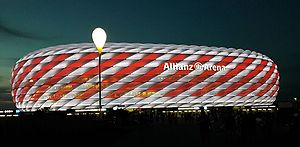
The new funds also allowed the club to build its own stadium. 2005 saw the move into the Allianz Arena in Munich-Fröttmaning, designed by Swiss architects Herzog & de Meuron and costing around 340 million euros. The stadium is operated by Allianz Arena München Stadion GmbH, which originally belonged half each to FC Bayern and TSV München von 1860. In 2006 though, FCB took over the stadium shares from TSV 1860 for about 11 million euros and thus became the sole owner of the stadium company. The liabilities for the stadium construction could be repaid in full as early as 2014.
Finally, the club's international marketing is also becoming increasingly important, in particular conquering the American and Asian markets where mainly the English Premier League clubs have been represented to date. In the hope of high profits from the sale of broadcasting and marketing rights, merchandising and sponsorship, FCB opened an office in New York (USA) in 2014. This was followed by the establishment of an office in Shanghai (China) in 2016, which was officially opened in March 2017. The paid-off new stadium and the transformation into a public limited company have cemented FC Bayern's status as a top player in the industry: in 2016, the company reported sales of EUR 626.8 million and a consolidated profit after taxes of EUR 33 million. By international comparison, these figures put the club in second place behind FC Barcelona (Spain).
Other sports departments
The following departments existed in FC Bayern München e.V. in 2016:
- Football – youth section / junior team (since 1902)
- Football – seniors (since 1911)
- Football – women's (since 1970)
- Football – referees (since 1919)
- Basketball
- Handball
- Table tennis
- Chess (since 1908)
- Sports bowling (since 1983)
The chess department was very successful, becoming German team champion nine times between 1983 and 1995 and winning the European Cup in 1992. The gymnastics department founded in 1974, whose most successful period was the 1980s with four German Championships, was dissolved in 2014. In 2011, the FCB basketball players returned to the 1. Bundesliga and celebrated its first German Championship after 59 years. In the same year, FC Bayern Basketball's business operations were spun off from the club and transferred to the legal form of a limited liability company.
References
- Elisabeth Angermair, Die Anfänge des Fußballspiels in München, in: Stadtarchiv München (Hg.), Fußball in München. Von der Theresienwiese zur Allianz-Arena, München 2006, 10-37.
- Julius Bohus, Geschichte des Sports in Bayern (Hefte zur bayerischen Geschichte und Kultur 20), Augsburg 1998.
- Heiner Gillmeister, The Tale of Little Franz and Big Franz: The Foundation of Bayern Munich FC, in: Soccer and Society 2 (2000), 80-106.
- Markwart Herzog, Die drei "Arierparagrafen" des FC Bayern München. Opportunismus und Antisemitismus in den Satzungen des bayerischen Traditionsvereins, in: Ders. (Hg.), Die "Gleichschaltung" des Fußballsports im nationalsozialistischen Deutschland, Stuttgart 2016, 75-113.
- Thomas Hüetlin, Gute Freunde. Die wahre Geschichte des FC Bayern München, München aktualisierte Taschenbucherstausgabe 2007.
- Dirk Kämper, Kurt Landauer. Der Mann, der den FC Bayern erfand, Zürich 2014.
- Matthias Kropp, Bayern München 1900-1993 (Agon-Sportverlag - statistics 9), Kassel 1993.
- Anton Löffelmeier, Der Fall Angelo Knorr - wie die Verfolgung Homosexueller vor 100 Jahren einen Vorsitzenden des FC Bayern München um Amt und Ansehen brachte, in: Oberbayerisches Archiv 138, München 2014, 159-177.
- Anton Löffelmeier, Fußballvereine, Geld und Politik. Die Geschichte des Münchner Fußballs von 1919 bis 1945, in: Stadtarchiv München (Hg.), Fußball in München. Von der Theresienwiese zur Allianz-Arena, München 2006, 38-77.
- Robert Schöffel, Fußball in München. Eine Stadt zwischen Rot und Blau, Regensburg 2014.
- Dietrich Schulze-Marmeling, Der FC Bayern und seine Juden. Aufstieg und Zerschlagung einer liberalen Fußballkultur, Göttingen 2011.
- Dietrich Schulze-Marmeling, Die Bayern. Die Geschichte des Rekordmeisters, Göttingen 4. Auflage 2009.
- Ingo Schwab, Die Münchner Vereine in den Zeiten der Fußball-Bundesliga (1963-2004), in: Stadtarchiv München (Hg.), Fußball in München. Von der Theresienwiese zur Allianz-Arena, München 2006, 130-171.
- Ingo Schwab, München in der Zeit der Oberliga Süd (1945-1963), in: Stadtarchiv München (Hg.), Fußball in München. Von der Theresienwiese zur Allianz-Arena, München 2006, 78-99.
- Hans Woller, Gerd Müller oder Wie das große Geld in den Fußball kam, München 2019.
Sources
- 1900-1950. Chronik über 50 Jahre Fußball-Club Bayern München e.V. Zur Jubiläumswoche vom 4. bis 11. Juni 1950, München 1950.
- Clubnachrichten / Bayern Magazin.
- Jahresberichte zum Ende der Spielsaison 1948/49, München o. J. [1949].
- Staatsarchiv Augsburg, Spruchkammer Akten Günzburg.
- Stadtarchiv München, Amt für Leibesübungen.
- Stadtarchiv München, Direktorium.
- Stadtarchiv München, Einwohnermeldekartei.
- Stadtarchiv München, Fotosammlung - Ereignisfotografie.
- Stadtarchiv München, Fotosammlung - Fotoalben.
- Stadtarchiv München, Fotosammlung - Rudi-Dix-Archiv.
- Stadtarchiv München, Ratssitzungsprotokolle.
External Links
Further Research
Related Articles
Münchner Bayern, die Bayern, die Roten, FC Hollywood, FCB, Rothosen
Cite
Daniel Baumann, FC Bayern Munich, first published 08 May 2017 (updated version 19 August 2019), English version published 21 February 2024; in: Historisches Lexikon Bayerns, URL: <https://www.historisches-lexikon-bayerns.de/Lexikon/EN:FC_Bayern_Munich> (21.12.2025)
